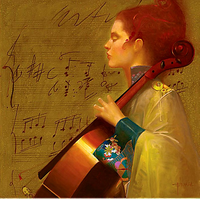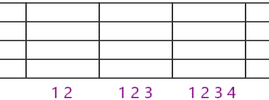Rests in Sheet Music
silent rhythm

Rests make music exciting!
-
Rests :
- Emphasize notes
- Comprise music's rhythm
- Indicate when a phrase ends
- Contrast Sound and Silence
Listen to music as phrases of sound. Then, instead of getting lost in counting rhythm, we hear a song's logic to help us understand the rests' rhythmic role.
Sheet music has different symbols for the various durations of rests (silence). Like their note counterparts, rests count rhythm. But rests' appearance is static, since they have no tone and don't change position on the staff as notes do.
Whole Rest

It hangs from the D line
A whole rest lasts an entire measure. The measure may be two, three, or four counts.
When whole rests appear, another instrument usually is playing, or your other hand on a keyboard. And whole rests may repeat for measures at a time.
Half Rest

It sits on the B line
A Half Rest lasts half as long as the whole rest. A half rest and additional notes combine to complete a measure's count. We could put two half rests in a measure of four counts, since each takes up half of the count, but a whole rest is the same duration.
With each division of a whole rest, there are more rests per measure. Keep in mind that notes (tones) eventually will be inserted between the rests, and will take up their own counts in a measure.
Measures get their name from measuring out units of time, or duration, in equal parts. The divisions can be in units of 2, 3, or 4. These units are beats. Each tone makes a sound that has a duration within the rhythm of the song. With rests, the rhythm is counted out, until the next note. Every element, notes and rests, get a count, or portion, of the measure's count - whether it's a count of 2, 3, or 4 beats per measure.

Quarter Rest
Half of a half rest, is a Quarter Rest. Four quarter rests take up all of a measure's count. If the count (beat) is in three, then three quarter rests can appear, though probably a dotted half rest counts the 3 rests in the measure (the dot is explained below).
Each quarter rest gets one beat per measure (a mixture of notes and rests probably would fill the remaining counts of the same measure).

Eighth Rest
Finally, half of a quarter rest, is an Eighth Rest. Eighth rests are used extensively between a melody's changing tones, like a comma. And the rhythm section of a band or orchestra makes use of eighth rests to offset upbeats from downbeats.

 Whole rest
Whole rest Half rest
Half rest Quarter rest
Quarter rest Eighth rest
Eighth rest
The Dot
We may not have enough rests to total a full measure's count, especially when rests and notes are mixed. To complete this missing count in a measure, add a simple Dot after a note or rest.
The Dot adds one half of a note/rest's value to itself. A quarter rest adds a half count, to become one and a half counts total. Count this dotted quarter rest as 1&2.
1& 2
However, a time signature where the eighth note is one beat, has a 3 beat rest. It is written as a quarter rest, followed by an eighth rest. In total, they have 3 beats, since the eighth rest gets one beat in a measure. They equal 3 eighth rests. Count the rests as 1&2& 3& (like 3 eighth rests, where one eighth rest gets one beat).

1&2& 3&
Finally, keep dividing the rests in half, to get smaller divisions. At the moment, we'll keep it simple. Once we get the hang of counting rhythm, we'll get into subtleties of sound (and rests). Rhythm is exciting, because it makes us want to move!
The next page has measures of notes, whose rhythm we divide into musical phrases.